Spring enrollment exceeds projection
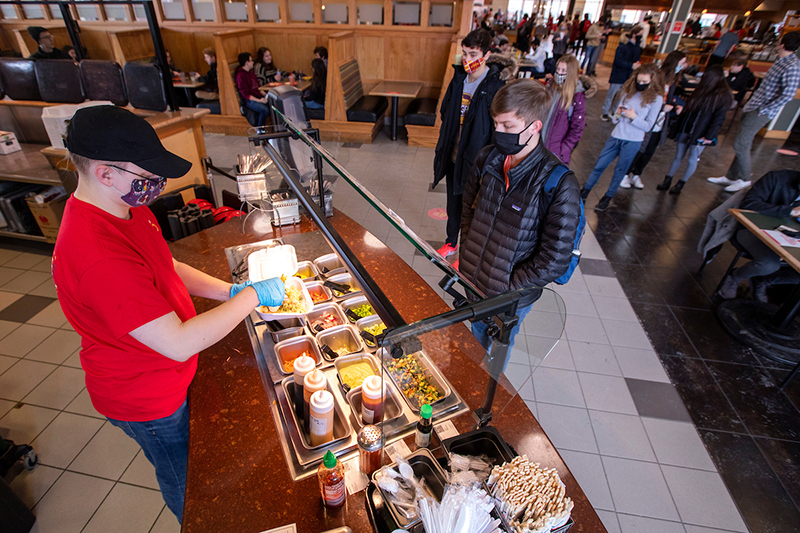
Junior and ISU Dining employee Caleb Myers prepares a made-to-order rice bowl for freshman Seth Larson at the bustling Marketplace inside the Union Drive Community Center Monday. Fall students returned for spring semester at the same rate they did a year ago. Photo by Christopher Gannon.
Iowa State enrolled 29,368 students this spring, re-enrolling from fall to spring semester at the same rate as a year ago and exceeding budgeted enrollment projections established in July, the start of the fiscal year. Among undergraduates eligible to register for spring classes, the same percentage -- 93% -- did enroll this year and last.
Overall, enrollment declined 1,405 students from spring semester 2020, nearly all in the undergraduate ranks. Graduate and professional student enrollment remained nearly steady.
Iowa State exceeded the spring enrollment projection it set last June by more than 200 students, said associate vice president for enrollment management Laura Doering. She praised the efforts of accounts receivables, financial aid, registrar and college advising staffs to identify and work with students who wanted to return to school but hadn't acted yet.
"I'm incredibly proud of how the campus came together to really focus on enrollment [as part of the Eligible to Enroll initiative]. A lot of people got involved in telling our students, 'We want you back. What can we do to help you?" she said. "Cyclones Care is a campaign about staying healthy, but it's also about how we support our students. We want our students to stay at Iowa State and be successful here -- if being at Iowa State is what's right for them.
"It was a great collaboration with the academic colleges, and all of that effort paid off," Doering said.
Spring semester enrollment
|
|
2021 |
2020 |
|
Resident students |
16,507 |
16,906 |
|
Undergraduate |
14,994 |
15,466 |
|
Graduate |
1,278 |
1,214 |
|
Professional* |
235 |
226 |
|
Nonresident students |
10,390 |
10,930 |
|
Undergraduate |
8,535 |
9,089 |
|
Graduate |
1,475 |
1,474 |
|
Professional* |
380 |
367 |
|
International students |
2,471 |
2,937 |
|
Undergraduate |
953 |
1,329 |
|
Graduate |
1,512 |
1,602 |
|
Professional* |
6 |
6 |
|
Total |
29,368 |
30,773 |
*Doctor of Veterinary Medicine
Domestic, international shifts
Enrollment differences over the past year are distributed fairly evenly across Iowa resident students, nonresidents and international students. Differences in domestic student enrollment are highest among underclassmen. Doering said COVID-19 concerns weigh heavily on students. While younger students may see benefits in a gap year or semester, upper level students with a longer investment in their educations are more likely to push through to the finish line despite adversity, she said. This was evidenced in the high representation of seniors in the five-week winter session.
A decline of 466 international students from spring 2020 to spring 2021 is most pronounced among the undergraduate classes. Doering said the health pandemic, travel ban, political climate and students' willingness to wait until after the pandemic for a fuller "American" college experience all played a role.
Fall to spring differences are normal
The difference between fall and spring enrollment (about 2,500 students) is consistent with past years, Doering said, and reflects several constants in higher education such as December graduation, first-time academic ineligibility and financial holds on student accounts.
As occurs in the fall semester, the university takes its spring enrollment count on the 10th day of class, Feb. 5 this semester.
Eligible to Enroll campaign adjusts, succeeds during pandemic
Helping current students doesn't stop when they leave the classroom. The pandemic has created many additional hurdles that could prevent some students from continuing their education.
That is where numerous colleges, offices, departments, faculty and staff have stepped in to assist through the Eligible to Enroll, Not Enrolled campaign.
"It creates an opportunity for students to connect with a resource within the university to help them navigate whatever is in the way of their registration," College of Liberal Arts and Sciences (LAS) associate dean Amy Slagell said. "We know interrupting time toward your degree can become a lifetime interruption, so it is important for students to have a connection to navigate their way back into the university."
The campaign began in the fall of 2016 and has been conducted during the fall and spring each year since. It provides a way to look at groups of students and determine how the university can better serve them. Making sure students are aware of available resources, and having the registrar's office and student financial aid be proactive is critical to the success of the campaign, senior associate registrar Shawna Saad said.
"This is a collaborative campaign across campus," she said.
A new process
The pandemic created a longer break between the fall and spring semesters this year, and the registrar's office, colleges and departments used it effectively.
"In December, the registrar's office provided student information to our college partners so they could do outreach and work with their departments and advisors," Saad said.
By January, colleges reported back to the registrar's office about the remaining students yet to enroll.The registrar sent a survey to students and guided them to the proper place based on their answers.
"Because of the extra time we had, at the end of January we took a final look at anyone still not enrolled and collaborated with colleges, the accounts receivable office and the office of student financial aid," Saad said. "As you can imagine, many of the students still on the list are not enrolling because they have a balance or are still working through their financial aid process."
That work -- including a phone call campaign to every student with a balance or hold on their account -- allowed some to return after receiving help.
Enrollment
The pandemic didn't result in a significantly higher number of students not enrolling in spring semester compared to spring 2020, Saad said.
At the start of the campaign Dec. 2, more than 5,000 students eligible to enroll for spring had yet to do so. After two months, the number had decreased to just over 1,000, Saad said.
"The fact that we remained at the same registration completion percentage despite the challenges faced this year could be considered a success," she said. "The number of personal outreaches to this group of students during a longer than normal break between semesters may have played a role in ensuring these students understood their options as they made decisions related to spring 2021 registration."
College-level effort
Before fall semester, each college conducted an intensive phone outreach effort to learn what was keeping students from enrolling.
One of the biggest efforts has been to work collaboratively with departments and colleges across campus to avoid overwhelming students while addressing their concerns as quickly and efficiently as possible.
"After we did a big push in June, we went back and looked, and it wasn't necessarily the calling or texting, but the emailing that was the most effective route," director of LAS student services Jennifer Owens said. "It was the persistence in the emailing. Our research showed it takes three emails to a student before they act on whatever you are sending them."
LAS student services specialist Mason Babcock compiles a list of eligible students who did not register as scheduled each week of registration. Advisors attempt to contact those students.
"In addition to the advisors, we asked departments to get involved this fall, and some departments had faculty calling students. We even utilized some student services staff to make calls as well," Owens said. "We also used Google Voice accounts to text with students."
An additional hurdle for freshmen enrolling from fall to spring was the fact most had never worked with the computer system.
"The way we did orientation last summer, very few freshmen made their own schedule," Owens said. "They were part of the process, of course, but they physically didn't enter the courses into the system. The advisor did that because we couldn't meet them in person."
The campaign offers colleges another connection point with students, especially during the challenging recent months.
"There are all kinds of resources students need and you don't know until you ask," Slagell said. "It is why this campaign is important because it is a check-in and part of the coordinated care the university tries to provide."
If a student must step away, Owens emphasizes they are welcome back when they are ready to return.
"Most students don't want to step out, it wasn't in their plan," she said. "It helps put them at ease."
Advisor role
The College of Engineering relies heavily on its academic advisors during the campaign because of the relationship built throughout a student's time on campus.
"The advisors are engaging with the student, and often multiple times throughout the semester," said Joel Johnson, College of Engineering director of student services. "The campaign has shown the critical role the academic advisor plays. They know the students well, and the students are communicating with them."
Each engineering department has an advising center with professional staff advisors, and a few departments use faculty to provide additional mentoring during the final two years. The advisors also communicate best methods to reach a student, and often know before the start of registration if there are issues or reasons a student plans to step away from the university.
Johnson said the campaign has been used long enough now to see the benefit it provides to the campus and students.
"I think it is a great partnership between the registrar, the student services offices and the advisors," he said. "It is that sharing of information and partnering together to identify students. This program has increased communication, collaboration and the understanding we are working for the common goal of having students reenroll."
P&S Council's annual pay proposal turns focus to benefits
Acknowledging the university's budget challenges, the Professional and Scientific Council's compensation and benefits recommendation for fiscal year 2022 focuses on benefits and policies instead of salary increases.
The council's annual recommendation typically suggests a specific percentage increase in pay for P&S staff meeting performance expectations, such as its call for FY21 raises to exceed inflation or for increases of 3-5% in FY20. Given the budget year beginning July 1 will mark the second consecutive year of an across-the-board 5% reduction, the council's compensation and benefits committee isn't proposing a specific performance-based salary increase.
"In a year consumed by a worldwide pandemic, a derecho that caused significant damage in Iowa, and (annual) budget cuts, we understand raises may not be possible," the compensation and benefits report states. "This is the attitude ISU staff has because we respect the mission of this university, and we want the organization to thrive."
The report and accompanying recommendation were presented for a first reading at the council's Feb. 4 meeting. Council members will consider final approval at their March 4 meeting.
Any small raise in FY22 would be appreciated, committee chair John Odenweller said. Premiums and copayments for health insurance went up Jan. 1, and faculty and P&S staff didn't receive a standard performance-based salary increase for the current year. But in an unprecedented time, the committee emphasized improvements it considers more likely than a boost in pay.
"The group tried to take a somewhat understanding and realistic outlook," Odenweller said.
Preserving existing employee contribution rates to benefits is one of the recommendations. Monthly health care premiums went up $20-25 in 2021, and most copayments for medical services and prescriptions increased by $5 or more. In announcing the changes in October, senior leaders said additional employee contributions are needed to cover rising health care expenses, and the 2021 increases -- the first premium hike in seven years -- likely will be followed in coming years by more incremental adjustments to close a deficit in the self-funded health plan.
The compensation report notes the added health plans costs implemented this year could amount to nearly 1% of the salary of an employee who makes $48,000 per year and suggests that further benefits cuts could diminish employee morale, recruitment and retention.
"The one bright spot in our compensation has consistently been the employee benefits package," the report states.
The recommendation also calls for:
- Creating a sustainable financial model that allows long-term commitments to staff
- Encouraging consistent policies and training
- Supporting mental health and well-being via flexible work arrangements and child care assistance
Winter success
In his regular update for the council, senior vice president and provost Jonathan Wickert said the first-ever winter session was a success by any measure, giving more than 2,100 students a chance to continue their academic progress during an unusually long winter break and generating an extra $3.6 million in revenue.
University leaders are exploring offering a winter session again, but the key question is how to adjust the academic calendar.
"We have a planning committee developing multiple options for what that might look like," Wickert said.
'Normal' by fall
Planning underway for the fall assumes a return to widespread in-person instruction, thanks to the expected deployment of COVID-19 vaccines, Wickert said. But the new normal may be a bit different from the old normal.
With the extensive experience faculty and students have with online instruction, more courses will be offered in that format than before the pandemic, he said. For employees, remote work and flexible work will be more common than before, too. That has prompted an analysis of how space in campus buildings should be configured to accommodate post-pandemic workplaces.
"Just like any other business, we're looking at it," Wickert said. "There are no announcements right now. We're just starting that discussion."
Spread the good news
Dire predictions about the pandemic having a negative academic impact haven't seemed to hold at Iowa State, Wickert said. First-year retention was a record high this fall (88.5%), and average student grades and academic standing status this fall were similar to previous semesters.
"Our campus is getting the job done, and I think that's an important message," he said.
Keeping students on track despite the challenging circumstances has relied on employee efforts that extend beyond the classroom, including academic advisors, tutors, instructional designers, counselors, the team that works on Canvas and many others, Wickert said.
"It's all the things working together as a system," he said. "I want to thank you for the role you played in that."
Behind the scenes
With the Iowa Legislature in session, bills that could impact Iowa State are often in the news. Wickert assured council members that the university is actively engaged with legislative issues, even when it's not publicly apparent.
"It's like an iceberg. There's a lot going on below the surface. You might not personally see a lot of activity or a lot of initiative on our campus on some of these bills. But just because you don't see it doesn't mean it isn't happening," he said.
Welcome
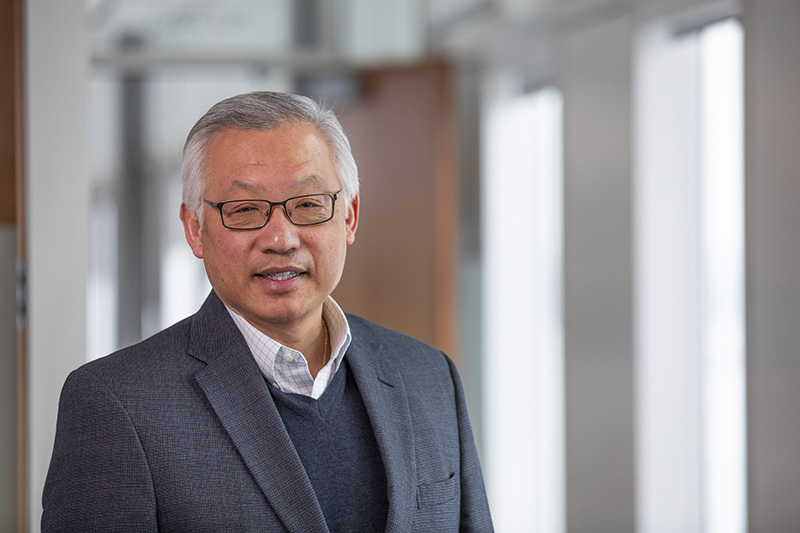
Peter Hong's first day on the job as the new director of the ISU Startup Factory was Feb. 1. In addition to leading Startup Factory, the university's yearlong accelerator program founded in 2016, Hong will help identify and develop other startup venture opportunities and manage Iowa State's role in Iowa Go-To-Market -- a soon-to-launch accelerator for more-developed research-driven startups jointly operated with BioConnect Iowa.
Hong earned a bachelor's degree in mechanical engineering from the University of Illinois, Urbana-Champaign, and worked in the agricultural and construction equipment industry before moving in to technical and business management. He's heavily involved in the network of agencies and entities promoting public and private support of Iowa entrepreneurship, currently serving as the vice chair of the Iowa Innovation Council and as a board member at BioConnect Iowa and the Iowa Advanced Manufacturing Council.
For the past 12 years, Hong has been chief operating officer and chief technology officer of New Tech Ceramics, a Boone-based startup. He's stepped away from a day-to-day role at New Tech but will continue his association with Larta Institute, where he's a principal advisor for the Los Angeles-based nonprofit's commercialization assistance programs.
Hong's office is in suite 1300 of Economic Development Core Facility. Contact him at 296-6429 or petehong@iastate.edu.
Five awards recognize efforts toward inclusivity
Faculty, staff and students will share the university's Martin Luther King Jr. Advancing One Community awards this year. Coordinated in the office of the vice president for diversity, equity and inclusion (DEI), the award recognizes individuals and campus organizations that demonstrate a commitment to fostering inclusive environments and promoting justice and equity at Iowa State -- in short, living the principles of King.
"Each awardee, by using their unique talents, has contributed through both insight and action to the better making of our Iowa State University community," said DEI vice president Reg Stewart. "As you can see from their accomplishments, there is no 'one way' to contribute to a more inclusive university, and we are deeply appreciative of their efforts -- which are especially noteworthy during this global pandemic.
"We encourage the Iowa State community to consider nominating a colleague, coworker, student or classmate for recognition in future years," Stewart added.
Due to COVID-19 precautions, awardees will not be recognized at an in-person ceremony this winter.
Congratulations to the five 2021 recipients of the award:
Employees
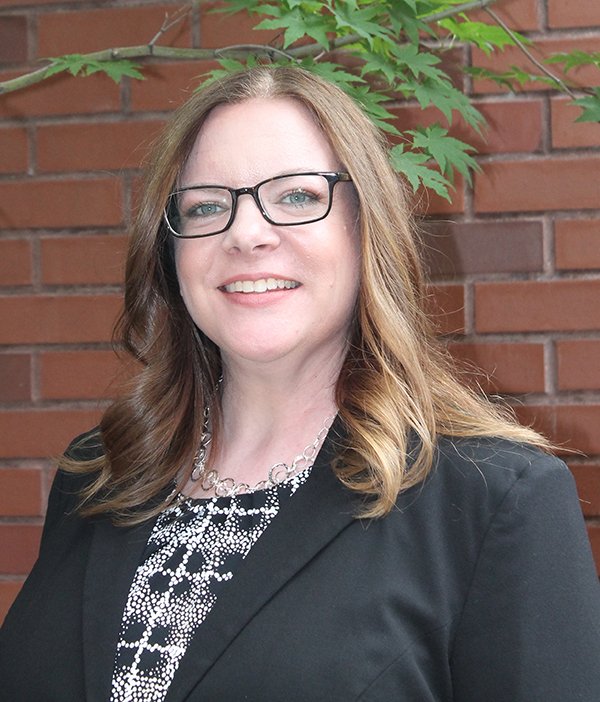
Leptien
Jennifer Leptien, director of learning communities
For her commitment to learning communities staff development, student leadership training and curriculum enhancements intentionally in diversity and inclusion. And for her lead role in the division of student affairs' completion (across the division) of the Intercultural Development Inventory, which assesses the intercultural competence of those who complete it.
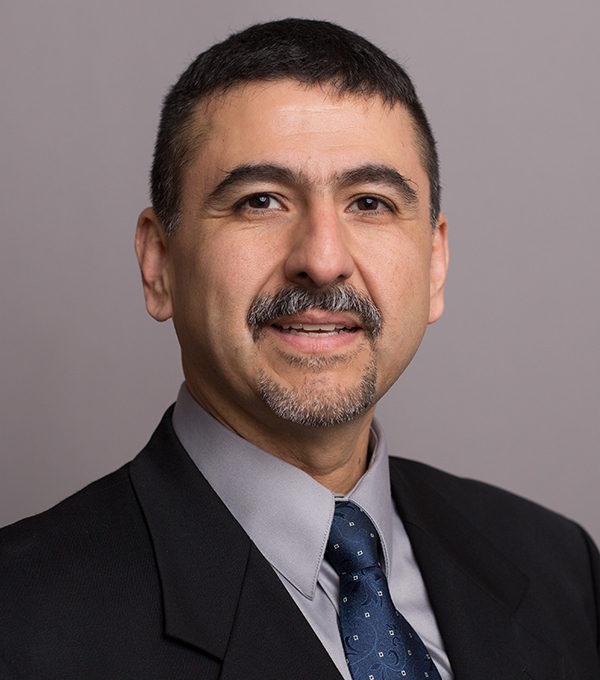
De León
J. Eliseo De León, adjunct assistant professor in food science and human nutrition, with a joint appointment in the DEI office
For his service to ISU's Hispanic community, including creating and coordinating the Lazos student engagement group and mentoring underrepresented students in STEM courses.
Students
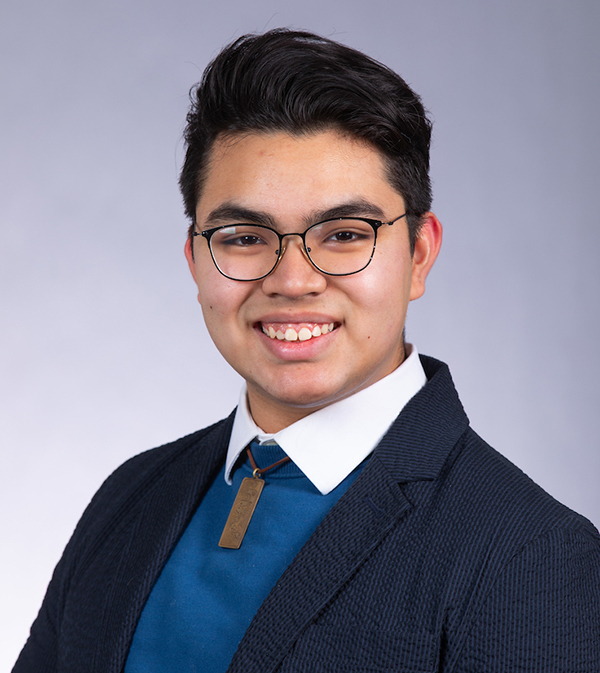
Peña Medina
David Peña Medina, sophomore in actuarial science
For imagining, researching and, with campus partners, organizing the Dreamers student engagement group for undocumented students, immigrants and allies. The group's existence fulfills a long-recognized need on campus that hadn't previously been developed into a sustainable initiative.
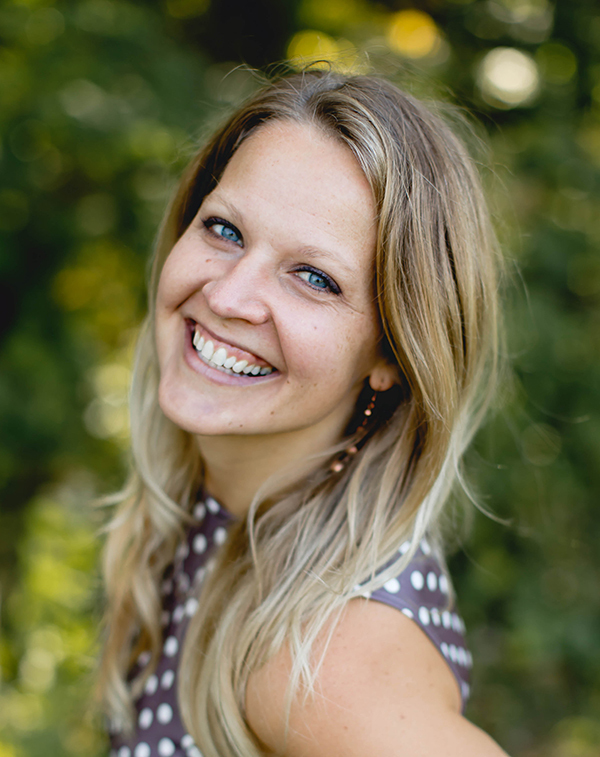
Gebhart
Nancy Gebhart, doctoral student in the School of Education and graduate assistant/equity and social justice coordinator in the Margaret Sloss Center for Women and Gender Equity
For her work advising the Society for the Advancement of Gender Equity, developing and leading the "Me and White Supremacy" book circle and coordinating the yearlong Primer on Protest Art series. In her former position as educator of visual literacy and learning for university museums, she helped produce and install the Principles of Community banners for Morrill Road light poles and envisioned and created the reACT Gallery in Morrill Hall to invite reflection and discussion of current events and issues through art exhibitions.
Group
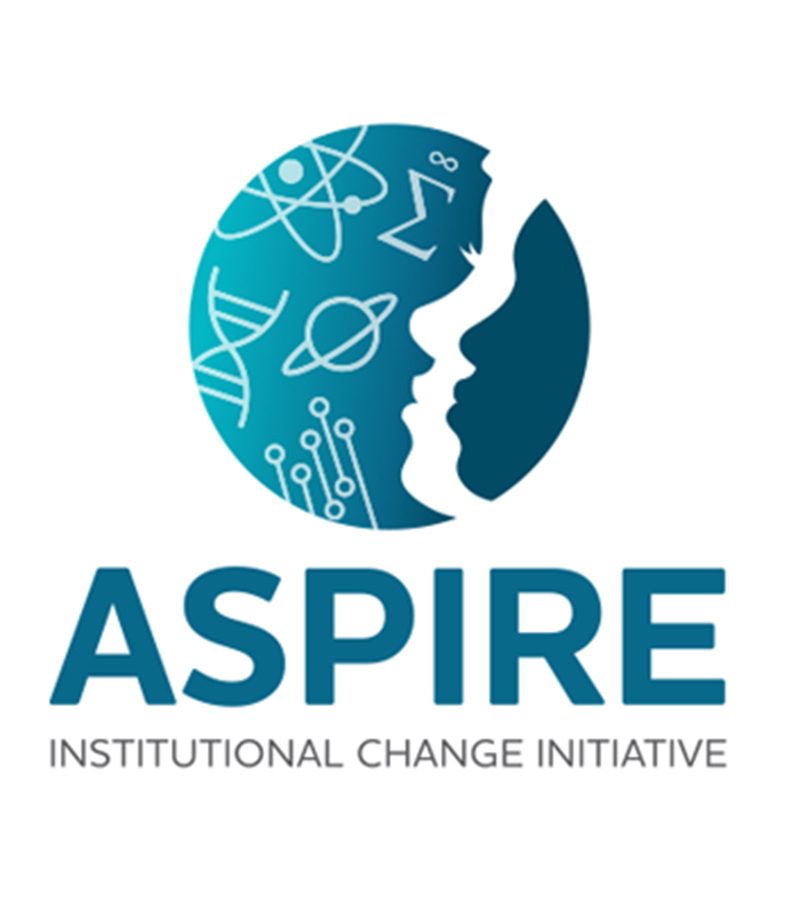
ISU's Aspire Alliance IChange Network Team, led by associate provost Dawn Bratsch-Prince and assistant provost Tera Jordan
For its collaborative, universitywide work since fall 2019 to improve the success and retention of underrepresented STEM faculty. In four work groups, the team currently is focusing on ISU relationships with minority-serving institutions and tribal colleges, underrepresented student enrollment, faculty recruitment, and faculty hiring and development.
Other members of the network team are: Clark Coffman, genetics, development and cell biology; Theressa Cooper and Dan Robison, College of Agriculture and Life Sciences administration; Becky Etnier, university human resources; Bill Graves, Graduate College; Ashfaq Khokhar, electrical and computer engineering; Julie LaBianca and Susan Ray, institutional research; Ann Oberhauser, sociology; nicci port and Reg Stewart, office of the vice president for diversity, equity and inclusion; James Reecy, office of the vice president for research; Heather Smith, office of university counsel; Dan Thomson, animal science; Javier Vela, chemistry; and Michael Young, math.
Building 'guardians' stay committed to a clean, safe campus
Editor's note: Custodial teams from all corners of campus, including residence, recreation services, athletics and the Memorial Union, have stepped up during the COVID-19 pandemic to adopt additional cleaning practices that help keep safe the people they serve. This story highlights the efforts of the facilities planning and management teams who clean academic and administrative buildings.
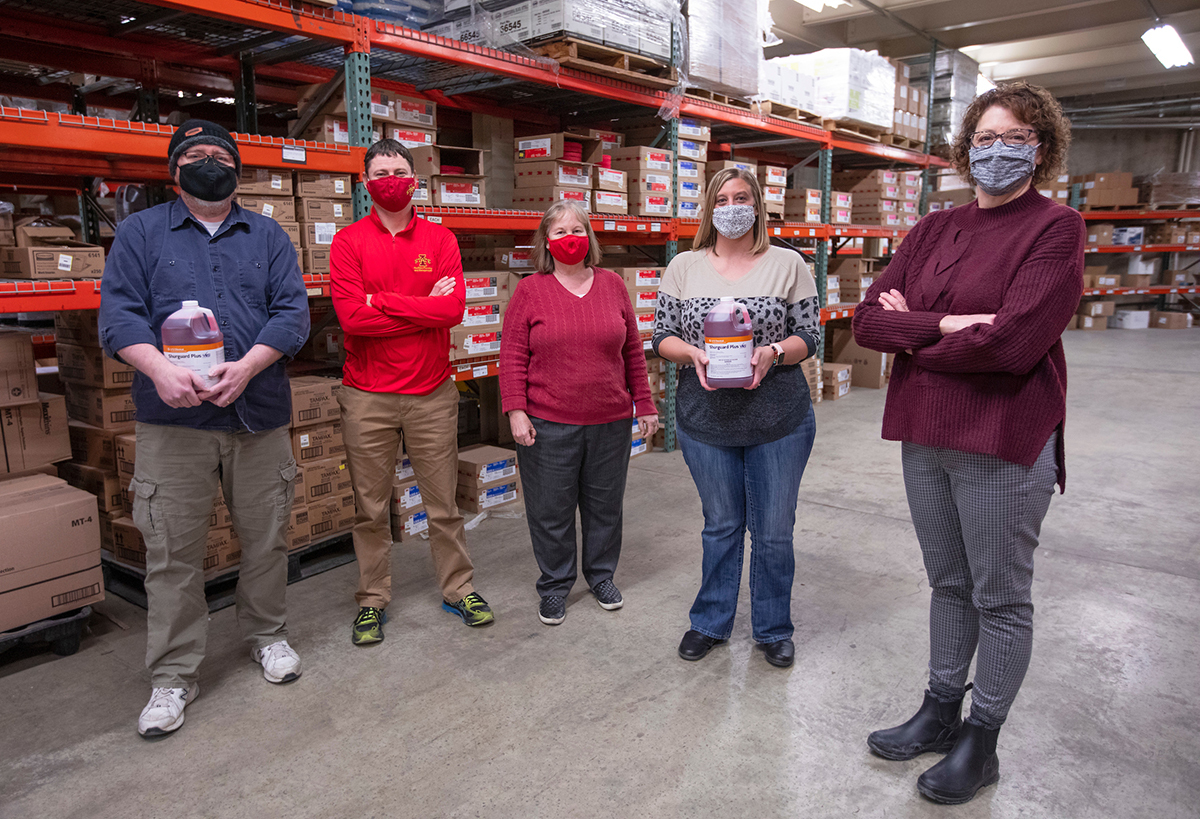
Custodial services senior manager Michelle Lenkaitis (right) with four of the unit's six area supervisors (l-r): Chris Rich-McKelvey, Anthony Gervais, Ellen Wiseman and Jodie Holzmer. Not pictured are daytime supervisor Chantel Joens and evening shift supervisor Stephanie Lang. Together the team coordinates about 170 custodians who keep campus academic and administrative buildings clean and safe during the pandemic. Photo by Christopher Gannon.
We call them custodians -- not janitors -- on our campus for a reason. Custodial services senior manager Michelle Lenkaitis notes the word means "guardian," and that's a pretty accurate fit, she said.
"They take great pride in their buildings. They really care for their buildings and the people who work in them," she said.
So, when the COVID-19 pandemic demanded changes to how -- and how frequently -- specific areas in Iowa State's administrative and academic buildings would be cleaned, custodians were acutely aware of what they weren't doing -- and they regretted it.
'When we told them they wouldn't be cleaning offices, that was huge for them. They felt they weren't meeting their responsibilities as a custodian in the building," Lenkaitis said.
For example, under the pandemic cleaning plan, custodians clean corridors once a week, but in the winter, corridors take a beating from snow and salt.
"They can't stand their floors being dirty, so they ask if they can clean them more often. If they have time, we advise them to please go ahead," Lenkaitis said. "The priorities remain the COVID cleaning and disinfecting."
Under an academic year plan announced in early July, custodians focus on four student-centered priorities for cleaning and disinfecting:
- Instructional spaces, including classrooms, auditoriums, teaching labs, open labs and seminar rooms: Cleaned and disinfected daily.
- Restrooms: Cleaned and disinfected daily.
- Parks Library (high-use areas): Cleaned and disinfected twice daily.
- Common areas (corridors, atriums, stairwells and elevators): Cleaned weekly. But frequently touched surfaces in those areas, such as door handles, drinking fountains, stair rails and elevator buttons are cleaned and disinfected daily.
Offices and administrative areas such as conference rooms, meetings spaces and break rooms will remain the cleaning responsibility of departments through spring semester.
Lenakaitis said most university employees have been "incredibly supportive" of the service changes. "I think people just want to know what to expect -- and then they move forward with that," she said.
A surprising number of employees even prefer to clean their own offices and preserve them as their private safe zones, she said.
Making a plan
Noteworthy service
For her leadership, Michelle Lenkaitis received an Exceptional Effort Award in exemplary operational support last month "for the successful creation and execution of enhanced cleaning and disinfection protocols."
Decisions about cleaning priorities weren't made in a vacuum. Last June, Lenkaitis prepared personnel and cost estimates for dozens of cleaning scenarios as she received them from facilities services director Bob Currie and associate vice president for facilities Paul Fuligni, who assembled numerous proposals by combining them. How many custodians and the price tag to clean classrooms every day? Every other day? Offices every day? Restrooms every day? Over several weeks, Currie and Fuligni submitted four proposals to the fall planning committee and cochairs of the emergency operations center, and senior leaders also signed off on the selected academic year plan.
The most comprehensive proposal, which never advanced, depended on 400-plus custodians -- Lenkaitis has around 120 -- so cost and priorities necessarily guided the discussions. To supplement the permanent custodians, she received permission to hire up to 71 temporary custodians for the academic year, a cost for which Iowa State will seek reimbursement from the Federal Emergency Management Agency. Lenkaitis realized over the first months of the semester she didn't need that many, which was fortunate because in an industry with steady turnover, it would have been difficult to retain that staffing level. She said the number of temporary custodians hovered around 50 during fall semester, with some occasionally transitioning into the university's continuous positions.
Last spring, this spring
The spring semester plan is to keep her 123 budgeted custodial positions full, supplement with about 30 temporary custodians and rely on a temp agency to provide additional help as needed to fill absences and vacations. The same campus cleaning and disinfecting priorities from fall remain in place for spring.
Anxiety among custodians this semester is not at the level it was last year when the global pandemic set in. Many university employees enjoyed the flexibility to work in the safety of their homes. Custodians didn't have that comfort.
"We knew a lot less back then about how COVID spread and they were frightened. They wanted to know about every positive case in a building that impacted them," Lenkaitis recalled.
You might say they cleaned their way out of some of that fear.
"The fact they were cleaning gave them a feeling of being in control. It made them feel safer," she said.
Custodial services also trained and equipped a dedicated team to clean and disinfect the workspace of employees who test positive for COVID-19, limiting that risk for most.
New structure
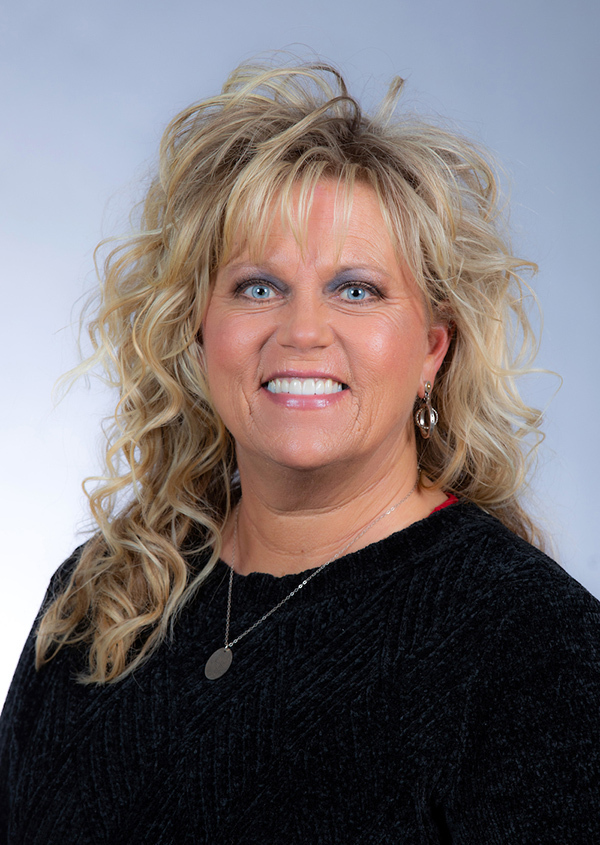
Custodial supervisor Stephanie Lang volunteered to lead a new evening shift needed this academic year to clean and disinfect all classrooms daily and add a second daily cleaning in Parks Library.
At the time they were training in COVID-19 cleaning and disinfecting protocols, custodians also were adjusting to a new organizational structure. Facilities' former 12 custodial teams were replaced with five geographic area teams on the day shift (4 a.m.-12:30 p.m.) and a new evening shift (4 p.m.-12:30 a.m.) which was necessary to clean the library a second time and all large classrooms and auditoriums once they emptied for the day. The new structure also helped the unit absorb 15 custodial positions lost to budget cuts last year. Some teams were split to suit the new structure.
"How and when and where they cleaned totally changed for many of them," Lenkaitis noted.
The six supervisors increased their direct reports, on average from 20 to 28 custodians, and the square footage they oversee. In addition to handling day-to-day issues, supervisors take care of Workday functions, order supplies, lead training and onboard new employees.
The pandemic halted monthly custodial meetings, but Lenkaitis quickly found her solution for connecting with all custodians: A Monday morning email they can read on their phones that not only delivers consistent messages and news to all readers, but addresses safety, shines a light on colleagues, provides equipment tips and recognizes their front-line-effort every week. The first issue mailed April 20, and Lenkaitis said its open rate averages in the low 80s, a "reflection of their need for information," she said. (Most employee newsletters are about half that successful).
"I am so proud of them as a unit and what they accomplished this fall," Lenkaitis said. "I feel really honored to work with them."
Related stories
Faculty concert celebrates Valentine's
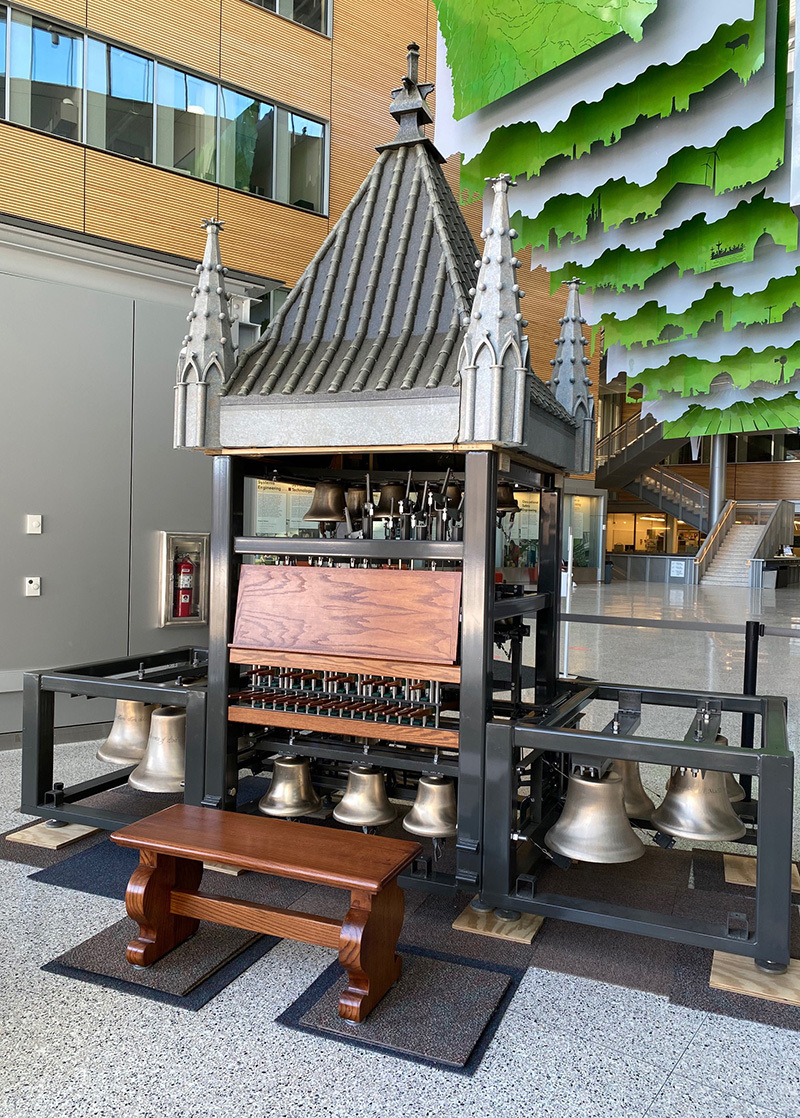
The one-fifth scale playable campanile/carillon model is housed in the Sukup Hall atrium. Contributed photo.
Music faculty will perform a Valentine's Day-themed concert on Friday, Feb. 12 (12:30 p.m.), in the Sukup Hall atrium. Cownie Professor of Music and university carillonneur Tin-Shi Tam will perform on the one-fifth campanile and carillon model. Chad Sonka, assistant teaching professor of voice, and Nathan Dishman, assistant professor of trombone, will perform with Tam on selected pieces.
In-person attendance is allowed, with face covering and physical distancing requirements in place. The ISU Society of Carillon Alumni and Friends will livestream the performance on its Facebook page.
Carillon concert program
Chad Sonka (baritone)
- "Till There Was You," Meredith Willson
- "If Ever I Would Leave You," Frederick Loewe
Tin-Shi Tam (carillon solo)
- "Fly Me To The Moon," Bart Howard
- "Salut d'Amour," Edward Elgar
Nathan Dishman (trombone)
- "Romance, Op. 21," Axel Jørgensen
Ninth annual P&S professional development experience goes virtual
Transitioning this year's Professional and Scientific (P&S) Council Professional Development Experience into a virtual offering reflects the event's annual goals of growth, connection and learning, said planning committee chair Tera Lawson.
"This has been a difficult year for many staff, and it is critical -- now more than ever -- to find creative ways to engage with colleagues across campus, but to do so in a safe space," she said.
"Cultivate Your Adventure: Growing Through Change," will be held virtually Thursday, Feb. 25 (8 a.m.-12:45 p.m. via Hopin).
Keynote speaker Renèe Smith has consulted with work cultures across the globe to help them thrive and be more caring and human-centered. She is founder and CEO of A Human Workplace, Tacoma, Washington, and has 20 years of organization development experience. Her 8:30 a.m. presentation is titled "Making Work More Human."
Participants also can take part in discussions on current topics, join networking opportunities and participate in wellness activities to close out the event. Registration is open through Feb. 22 and costs $25. More information about the keynote speaker, schedule of events and registration is on the conference website.
Attendees have the option to participate in one of four 90-minute experiential learning sessions with Smith scheduled March 10-12. Participants discover and practice essential human skills and learn more about evidence-based well-being practices they can use in their daily lives. This session costs an additional $15 on the registration site.
